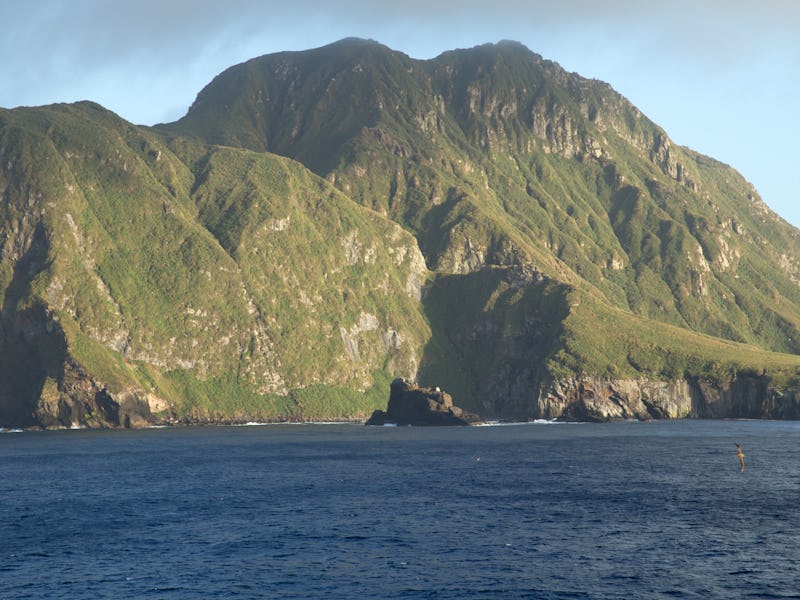An uninhabited island in the Atlantic is surprisingly covered in plastic bottles
Scientists think it means ships are dumping plastic far from its origin.

Plastic is everywhere. It’s in the Arctic, in the oceans, and even in our poops. It’s not yet clear whether plastic waste causes health problems for humans and other animals, but one thing is clear: The Earth is littered with it.
That’s where Inaccessible Island, a tiny, uninhabited island in the South Atlantic Ocean, comes in. Halfway between Africa and South America, it’s many many miles from anything. Needless to say, Inaccessible Island doesn’t seem like it should be covered in plastic trash. But it is. New research in Proceedings of the National Academy of Sciences suggests that scientists think they know the source of some of it.
In a paper published on Monday, a team of researchers tracked incoming plastic bottles on Inaccessible Island for over two months, and found that most of it came from East Asia. But that doesn’t mean it washed from Pacific shores and floated all the way to the Atlantic.
Rather, scientists think that it means ships are dumping plastic into the ocean far from its origin.
“[A] small proportion of the bottles originating from India and Southeast Asian countries might reach the South Atlantic from the Indian Ocean via the Agulhas Current, but this will take 3 to 5 [years],” writes the team, led by Peter G. Ryan, Ph.D., director of the FitzPatrick Institute of African Ornithology at the University of Cape Town in South Africa.
“Debris originating from China, Taiwan, Japan, and Korea is mostly entrained into the North Pacific, with very little chance of drifting to the South Atlantic.”
Notably, the stamped dates on bottles that washed ashore during the collection period revealed that they’d been produced within two years of arriving at Inaccessible Island.
There’s almost no way, they suggest, that a bottle could have been produced in East Asia, used, and discarded then show up in the South Atlantic within that short of a time period — other than being dumped from a ship, of course.
Study co-author Maëlle Connan inspects bottles to see where they came from.
And not only does Inaccessible Island already have an incredible volume of bottles on its shores, but the team found that more bottles are showing up each year than the one before.
“The numbers of drink bottles at Inaccessible Island have increased at more than twice the rate of nonbottle debris during the last 3 decades,” they write.
“This largely reflects the 8.5% per year growth in the bottled water industry, which is projected to be worth US $280 billion by 2020.
This bottle has been colonized by goose barnacles.
Part of that increase could be due in part to declining water quality in cities around the world.
Also on Monday, another study was released in PNAS showing that water contamination involving immediate risk leads to significant increases in water bottle sales. And while this study was conducted for counties in the United States, poor tap water quality in China and increasing incomes have led to a boom in the country’s bottled water market.
So while these studies unfortunately don’t provide a roadmap of how the global plastic pollution problem can improve, at least they give us a better sense of how much worse it’s gotten.
Abstract:
Most plastic debris floating at sea is thought to come from land- based sources, but there is little direct evidence to support this assumption. Since 1984, stranded debris has been recorded along the west coast of Inaccessible Island, a remote, uninhabited island in the central South Atlantic Ocean that has a very high macrodebris load (∼5 kg·m−1). Plastic drink bottles show the fastest growth rate, increasing at 15% per year compared with 7% per year for other debris types. In 2018, we examined 2,580 plastic bottles and other containers (one-third of all debris items) that had accumulated on the coast, and a further 174 bottles that washed ashore during regular monitoring over the course of 72 d (equivalent to 800 bottles·km−1·y−1). The oldest container was a high-density polyethylene canister made in 1971, but most were polyethylene terephthalate drink bottles of re- cent manufacture. Of the bottles that washed up during our survey, 90% were date-stamped within 2 y of stranding. In the 1980s, two- thirds of bottles derived from South America, carried 3,000 km by the west wind drift. By 2009, Asia had surpassed South America as the major source of bottles, and by 2018, Asian bottles comprised 73% of accumulated and 83% of newly arrived bottles, with most made in China. The rapid growth in Asian debris, mainly from China, coupled with the recent manufacture of these items, indicates that ships are responsible for most of the bottles floating in the central South Atlantic Ocean, in contravention of International Convention for the Prevention of Pollution from Ships regulations.